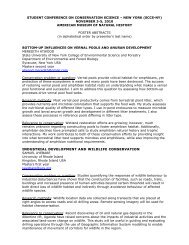"Life and the Evolution of Earth's Atmosphere." Earth
"Life and the Evolution of Earth's Atmosphere." Earth
"Life and the Evolution of Earth's Atmosphere." Earth
- No tags were found...
You also want an ePaper? Increase the reach of your titles
YUMPU automatically turns print PDFs into web optimized ePapers that Google loves.
Stromatolites in Western Australia, today. Did ancient<strong>Earth</strong> look like this?billion years ago. So, <strong>the</strong> origin <strong>of</strong> life isprobably <strong>the</strong> origin <strong>of</strong> evolution. <strong>Life</strong> isresourceful <strong>and</strong> entrepreneurial. It takesadvantage <strong>and</strong> it changes <strong>the</strong> chemistry <strong>of</strong> itssurroundings. <strong>Life</strong> is a fantastically complexsystem, <strong>the</strong> emergence <strong>of</strong> which remains <strong>the</strong>greatest mystery in science.Long-term changes in <strong>the</strong> composition <strong>of</strong> <strong>the</strong>atmosphere <strong>and</strong> oceans are intimately linked toboth <strong>the</strong> geophysical changes in <strong>the</strong> solid <strong>Earth</strong>itself <strong>and</strong> with <strong>the</strong> ongoing evolution <strong>of</strong> life. Theatmosphere <strong>and</strong> oceans first appeared about4.5 billion years ago, soon after <strong>the</strong> <strong>Earth</strong> <strong>and</strong>Moon completed <strong>the</strong>ir formational phase. Thiswas <strong>the</strong> time when gases escaping throughvolcanoes made an envelope <strong>of</strong> atmospherearound <strong>the</strong> young <strong>Earth</strong>, <strong>and</strong> a primitive crustsolidified <strong>and</strong> cooled to <strong>the</strong> point where liquidwater could condense. Water began poolinginto <strong>the</strong> first lakes, seas, <strong>and</strong> oceans. Theinteraction <strong>of</strong> water, heat, <strong>and</strong> rock set <strong>the</strong>stage for <strong>the</strong> origin <strong>of</strong> life.From <strong>the</strong> beginning, a number <strong>of</strong> factors haveaffected <strong>the</strong> makeup <strong>of</strong> <strong>the</strong> atmosphere tochange it from its initial state to what we havetoday. Several <strong>of</strong> <strong>the</strong>se factors, such as platetectonics, wea<strong>the</strong>ring (which recycle rocks,water, <strong>and</strong> gases), <strong>and</strong> chemical changesinduced by <strong>the</strong> byproducts <strong>of</strong> life itself, areinternal to <strong>the</strong> planet. However, external factorssuch as <strong>the</strong> slowly but ever-increasingluminosity <strong>of</strong> <strong>the</strong> Sun over billions <strong>of</strong> years,gradual changes in <strong>the</strong> <strong>Earth</strong>’s orbit over manytens <strong>of</strong> thous<strong>and</strong>s <strong>of</strong> years, <strong>and</strong> <strong>the</strong> rare butcatastrophic impacts <strong>of</strong> giant meteorites <strong>and</strong>comets, have also played an important role.The atmosphere <strong>of</strong> our planet did not originallycontain all <strong>the</strong> free, breathable oxygen it doesnow. The first permanent atmosphere arosewhen gases that had been dissolved in <strong>the</strong>molten planet during its assembly from smallerbodies, called “planetesimals,” were released to<strong>the</strong> surface by volcanism. That first, primitiveatmosphere was probably several times denserthan what we have now, <strong>and</strong> was dominatednot by oxygen, but by carbon dioxide—amajor greenhouse gas. O<strong>the</strong>r gases, such asmolecular nitrogen, water vapor, <strong>and</strong> smallamounts <strong>of</strong> carbon monoxide, sulfur gases, <strong>and</strong>trace quantities <strong>of</strong> methane, <strong>and</strong> hydrogen werealso present.Astrophysical computer models based on <strong>the</strong>study <strong>of</strong> young stars <strong>and</strong> <strong>of</strong> star-forming regionsin <strong>the</strong> galaxy strongly suggest that <strong>the</strong> Sun wasmuch dimmer when <strong>the</strong> first life emerged on<strong>Earth</strong>, over 4 billion years ago. A dimmer Sunwould have supplied less solar radiation towarm <strong>the</strong> early <strong>Earth</strong>. To keep <strong>the</strong> <strong>Earth</strong> fromstarting out as a frozen wastel<strong>and</strong>, with no hopefor beginning life to take hold, an atmospheric“greenhouse” must have kept <strong>the</strong> surface zonewarm enough to maintain water in liquid form.Liquid water is <strong>the</strong> prerequisite for life.Greenhouse gases in much higher abundancethan today, primarily water vapor, carbondioxide, <strong>and</strong> methane, would have formed a<strong>the</strong>rmal blanket over <strong>the</strong> surface <strong>of</strong> <strong>the</strong> early<strong>Earth</strong> that strongly absorbed outgoing <strong>the</strong>rmalradiation. This leads to a significantly enhanced,warming “greenhouse effect” that <strong>of</strong>fset <strong>the</strong>dimmer Sun. Without this very different,greenhouse gas-rich <strong>and</strong> oxygen-poor earlyatmosphere to begin with, life would havegotten a frozen start. (See <strong>the</strong> essay by CharlesF. Keller in Section Five, which discussesgreenhouse gases <strong>and</strong> global warming.)The composition <strong>of</strong> this early atmosphere, sodifferent from <strong>the</strong> one we have now, would bedeadly for most life that is not a primitivebacterium. Soon after <strong>the</strong> emergence <strong>of</strong> <strong>the</strong>first life more than 4 billion years ago, <strong>the</strong>activities <strong>of</strong> organisms began to influence <strong>the</strong>composition <strong>of</strong> <strong>the</strong> atmosphere. As <strong>Earth</strong>’sbiosphere <strong>and</strong> atmosphere co-evolved over
















